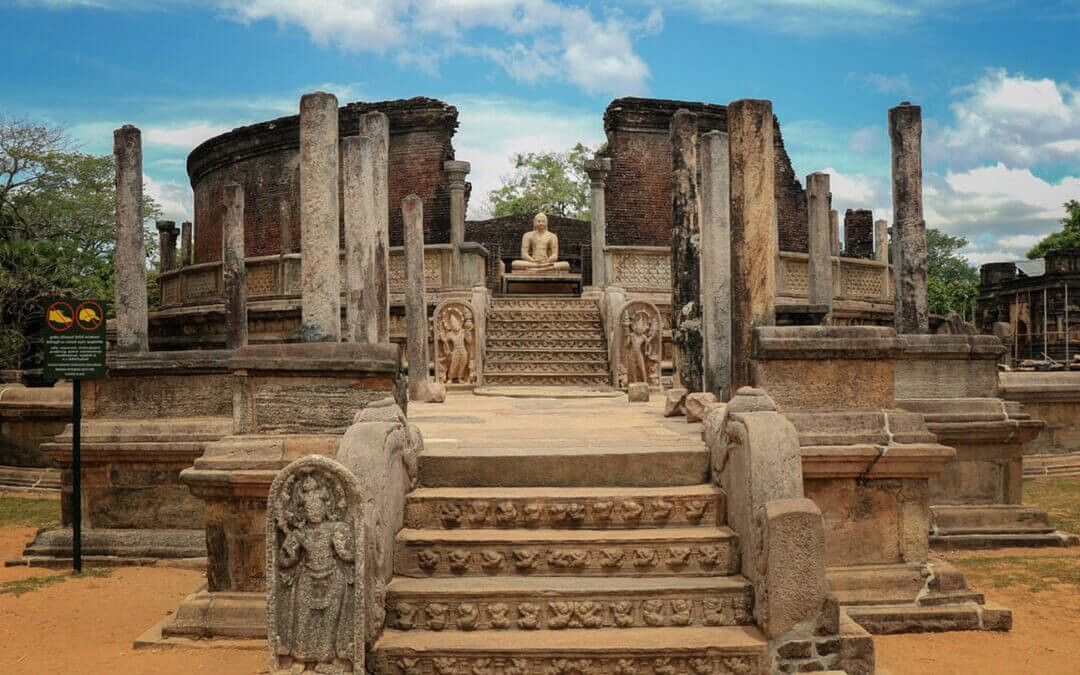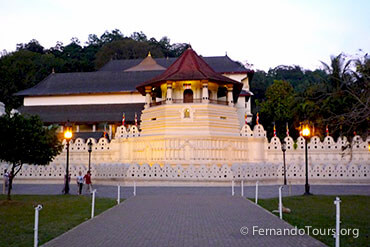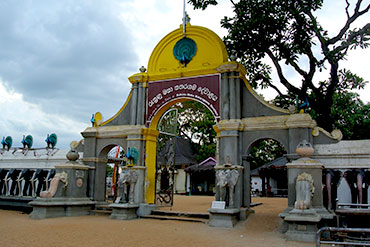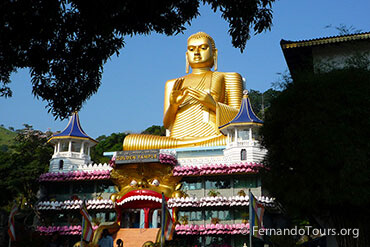
History & Culture
Nestled in the heart of Sri Lanka, the ancient city of Polonnaruwa stands as a testament to the island’s rich cultural and historical heritage. This UNESCO World Heritage Site invites travelers on a captivating journey through time, where meticulously preserved ruins unfold the grandeur of a bygone era.
Polonnaruwa, once the thriving second capital of medieval Sri Lanka, boasts a remarkable collection of ancient structures and artifacts. The city’s archaeological treasures include majestic temples, royal palaces, and intricately carved statues, each narrating stories of a sophisticated civilization.
Wandering through the well-preserved ruins, visitors are transported to a time when Polonnaruwa was a flourishing center of trade, culture, and religious significance. The Gal Vihara, a group of monumental Buddha statues carved from a single granite rock, stands as an awe-inspiring testament to the artistic prowess of the ancient craftsmen.
The city’s sacred spaces, such as the Quadrangle and the Rankoth Vehera, showcase the architectural brilliance of the Polonnaruwa kingdom. Intricate carvings and stonework offer glimpses into the spiritual and artistic dimensions of this ancient civilization.
Surrounded by lush greenery and bordered by the scenic Parakrama Samudra reservoir, Polonnaruwa’s archaeological park provides a serene backdrop for exploration. Cycling or strolling through the site, visitors can appreciate the city’s layout and the strategic planning that characterized this medieval urban center.
Polonnaruwa not only serves as a historical marvel but also as a living testament to the enduring legacy of Sri Lanka’s cultural heritage.

History & Culture
The Temple of the Sacred Tooth Relic, located in Kandy, Sri Lanka, is a revered spiritual and cultural landmark. This sacred site houses what is believed to be a relic of the tooth of Lord Buddha, making it one of the holiest places for Buddhists worldwide.
Nestled within the Royal Palace complex, the temple’s architecture seamlessly blends traditional Kandyan and South Indian styles. The structure is adorned with intricate carvings, golden embellishments, and a distinct red-tiled roof, reflecting the rich cultural heritage of the region.
Upon entering the temple, visitors are greeted by the soothing sounds of chanting and the fragrance of burning incense. The inner sanctum, where the sacred tooth relic is enshrined, is a place of deep reverence and spirituality. Devotees and tourists alike are captivated by the serene ambiance and the palpable sense of devotion that permeates the air.
The Temple of the Sacred Tooth Relic is not only a religious center but also a repository of Sri Lanka’s history. The adjacent museum showcases artifacts, gifts, and historical records, offering a comprehensive understanding of the temple’s significance and its role in the country’s cultural narrative.
The temple complex is set against the backdrop of the scenic Kandy Lake and surrounded by lush greenery, providing a tranquil setting for reflection and contemplation. Timing your visit to coincide with the evening pooja (religious ceremony) adds a magical touch, as the temple is illuminated, creating a spiritually charged and visually stunning atmosphere.
For those seeking a profound cultural and spiritual experience, the Temple of the Sacred Tooth Relic stands as a beacon of devotion and heritage, inviting visitors to partake in the tranquility and sacredness that define this revered site.

History & Culture
The Cultural Show in Kandy is a vibrant and captivating spectacle that provides a glimpse into the rich cultural heritage of Sri Lanka. Held in the historic city of Kandy, a UNESCO World Heritage Site, this cultural performance is a celebration of traditional music, dance, and folklore.
The show typically takes place in the evening and is hosted in dedicated venues, offering locals and tourists an opportunity to experience the diverse cultural tapestry of the island. Here’s what you can expect from the Cultural Show in Kandy:
1. Traditional Dance: The performance showcases a variety of traditional dances that have been passed down through generations. These dances often represent different regions of Sri Lanka and are characterized by colorful costumes, intricate footwork, and expressive movements.
2. Drumming: Sri Lanka has a rich tradition of drumming, and the Cultural Show highlights the rhythmic beats of traditional drums. Drum ensembles create a dynamic and energetic atmosphere, adding a rhythmic pulse to the performance.
3. Fire Walking: Some cultural shows in Kandy feature the awe-inspiring act of fire walking. Performers, often devotees of the Kataragama deity, walk barefoot across a bed of burning coals, showcasing their spiritual devotion and physical endurance.
4. Kandyan Art: The show may also include demonstrations of Kandyan art forms, such as the intricate craftsmanship of local artisans. This could involve traditional handloom weaving, mask making, or other crafts unique to the region.
5. Folk Music: Traditional folk music, played on indigenous instruments, is an integral part of the Cultural Show. The melodies and rhythms convey the stories and cultural nuances of Sri Lanka.
Attending the Cultural Show in Kandy is not only a visual and auditory delight but also an opportunity to appreciate the diversity and depth of Sri Lanka’s cultural heritage. It provides a memorable and immersive experience for those seeking to connect with the traditions and artistic expressions of this enchanting island.
Please note there is an entrance fee to The Cultural Show in Kandy.

History & Culture
Kataragama Temple, situated in the town of Kataragama in southern Sri Lanka, is a revered religious site that holds significance for multiple religious communities. Here are key features of the Kataragama Temple:
1. Multireligious Sanctuary: The temple complex is unique in that it is sacred to followers of various religions, including Hindus, Buddhists, Muslims, and indigenous Vedda people. It serves as a symbol of religious harmony and coexistence.
2. Lord Kataragama: The main deity worshipped at the temple is Lord Kataragama, also known as Skanda or Murugan in Hinduism. He is considered the God of War and Victory and is highly venerated by devotees who come to seek blessings, especially during the annual Kataragama Esala Festival.
3. Murugan Kovil: The main sanctum, known as the Maha Devale or Murugan Kovil, is dedicated to Lord Kataragama. Pilgrims offer various forms of devotions, including prayers, vows, and the ritual of walking on hot coals known as the “fire walking” ceremony.
4. Shrines for Other Deities: The temple complex also includes shrines dedicated to other Hindu deities, such as Lord Ganesha and the goddess Valli Amman. Devotees pay their respects at these shrines as part of their religious practices.
5. Buddhist Presence: In addition to the Hindu components, the temple complex includes a Buddhist stupa, reflecting the shared religious history of the region. Buddhists believe that Kataragama is associated with Skanda/Kumara in Buddhist tradition.
6. Islamic Shrine: The mosque within the temple complex is dedicated to the Muslim saint Al-Khidr. This inclusion highlights the syncretic nature of religious practices at Kataragama and the mutual respect among different faiths.
7. Annual Esala Festival: The Kataragama Esala Festival, held in July or August, is a major religious event that attracts devotees from different communities. The festival includes colorful processions, rituals, and ceremonies, creating a vibrant and festive atmosphere.
8. Vedda Community: The indigenous Vedda people, the original inhabitants of Sri Lanka, also participate in the religious practices at Kataragama. Their presence and rituals contribute to the diverse and inclusive nature of the temple.
Kataragama Temple stands as a testament to the cultural and religious diversity of Sri Lanka, where people of different faiths come together in a spirit of unity and shared reverence. It is a place where traditions intersect, and the coexistence of various religious practices is celebrated.

History & Culture
The Dambulla Cave Temple, also known as the Golden Temple of Dambulla, is a UNESCO World Heritage Site in Sri Lanka. It is located in the central part of the country, near the town of Dambulla. The temple complex is renowned for its ancient cave temples, stunning murals, and numerous Buddha statues. Here are some key features and information about the Dambulla Cave Temple:
1. Historical Significance: The Dambulla Cave Temple has a history that dates back to the 1st century BCE when King Valagamba took refuge in these caves during an invasion. After regaining his throne, he converted the caves into a rock temple.
2. Cave Complex: The temple complex consists of five caves that are carved into a large granite rock. These caves are interconnected and house a vast collection of Buddhist murals, sculptures, and statues.
3. Buddha Statues: The caves contain over 150 statues of Buddha in various poses and sizes. The largest and most impressive is a 14-meter long reclining Buddha statue in the first cave.
4. Wall Paintings: The interiors of the caves are adorned with intricate and well-preserved ancient frescoes that depict scenes from the life of Buddha, as well as various deities and historical events.
5. Cave Names and Themes:
– Cave 1: The Devaraja Lena (Cave of the Divine King) features a 14-meter long reclining Buddha statue.
– Cave 2: The Maharaja Lena (Cave of the Great Kings) contains statues of standing and seated Buddhas.
– Cave 3: The Maha Alut Viharaya (Great New Temple) features a stupa and various seated Buddha statues.
– Cave 4: The Pachima Viharaya (Western Temple) includes a large statue of the meditating Buddha.
– Cave 5: The Devana Alut Viharaya (Second New Temple) houses various Buddha statues and paintings.
6. Golden Temple: The exterior of the caves and the surrounding area are adorned with a golden facade, giving the temple its nickname, the “Golden Temple of Dambulla.”
7. Cultural Importance: The Dambulla Cave Temple is a significant pilgrimage site for Buddhists and is considered one of the most well-preserved cave temple complexes in Sri Lanka.
8. UNESCO World Heritage Site: In 1991, the Dambulla Cave Temple was designated as a UNESCO World Heritage Site in recognition of its cultural, archaeological, and artistic significance.
9. Visitor Facilities: The site has facilities for visitors, including a museum that provides more information about the history and significance of the temple complex.
Visiting the Dambulla Cave Temple offers not only a spiritual experience but also an opportunity to admire the ancient art and architecture that has been preserved for centuries. The site attracts both pilgrims and tourists interested in Sri Lanka’s rich cultural heritage.
Kindly be advised that there is an entrance fee for visiting The Dambulla Cave Temple.




